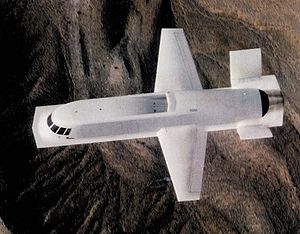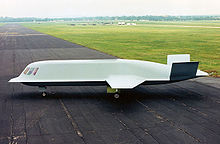Northrop Tacit Blue Video - Promo film
|
|
Northrop Tacit Blue
Tacit Blue

Role: Stealth demonstrator
Manufacturer: Northrop
First flight: February 1982
Retired: 1985
Status: Museum piece
Primaryuser: United States Air Force
Number built: 1
The Northrop Tacit Blue was a technology demonstrator aircraft created to demonstrate that a stealth low observable surveillance aircraft with a low probability of intercept radar and other sensors could operate close to the forward line of battle with a high degree of survivability.
Development
Unveiled by the U.S. Air Force on 30 April 1996, the Tacit Blue Technology Demonstration Program was designed to prove that such an aircraft could continuously monitor the ground situation deep behind the battlefield and provide targeting information in real-time to a ground command center. Tacit Blue represented the 'black' component in the larger Assault Breaker program, which intended to validate the concept of massed standoff attacks on advancing armoured formations using smart munitions. The Pave Mover radar demonstrators provided the non-stealthy portion of the program's targeting system, whereas Tacit Blue was intended to demonstrate a similar but stealthy capability, while validating a number of innovative stealth technology advances.
Tacit Blue, nicknamed "the whale," featured a straight tapered wing with a V-tail mounted on an oversized fuselage with a curved shape. A single flush inlet on the top of the fuselage provided air to two high-bypass turbofan engines. Tacit Blue employed a quadruply redundant, digital, fly-by-wire flight control system to help stabilize the aircraft about its longitudinal and directional axes.
The sensor technology developed for Tacit Blue is now being used by the E-8 Joint STARS aircraft.
Operational history

Picture - Northrop engineer John Cashen was quoted in 1996 as having said, 'You are talking about an aircraft that at the time was arguably the most unstable aircraft man had ever flown.'[1]
The aircraft made its first flight in February 1982, and subsequently logged 135 flights over a three year period. The aircraft often flew three to four flights weekly and several times flew more than once a day. After reaching about 250 flight hours, the aircraft was placed in storage in 1985. In 1996, Tacit Blue was placed on display at the National Museum of the United States Air Force at Wright Patterson Air Force Base, near Dayton, Ohio. Tacit Blue is on display in the Research and Development Hangar (within the Wright-Patterson Air Force Base perimeter and away from the main National Museum site).
Specifications
General characteristics
Crew: 1
Length: 55 ft 10 in (17 m)
Wingspan: 48 ft 2 in (14.7 m)
Height: 10 ft 7 in (3.2 m)
Loaded weight: 30,000 lb (13,606 kg)
Powerplant: 2x— Garrett ATF3-6 high-bypass turbofans, 5,440 lbf (24 kN) each
Performance
Maximum speed: 287 mph (461.88 km/h)
Service ceiling: 30,000 ft (9,144 m)
Thrust/weight: 0.36
Comparable aircraft
Lockheed Have Blue
Living Warbirds: The best warbirds DVD series.
Source: WikiPedia